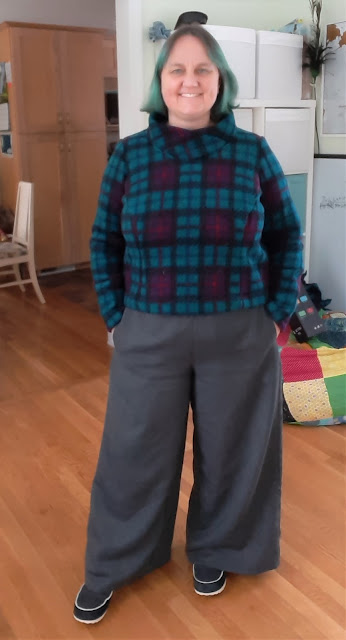I'm a bit late posting this make. I made it way back in early January but I think I'm all caught up with blogging for a while now.
Whilst I've needed new nightwear for a while I never seem to get around to making it, but then my Sewing Guild group decided to have a zoom pajama party. The idea was to make some night wear and show it off at our next zoom meeting. Sounds like a good time to finally get around to it.. Of course I went and made this, and then totally forgot on the night of the meeting and missed my chance to show it off......isn't that right! Oh well it was a good push to get it made.
Fabric: I used a piece of white and red flannel that I had in stash.
Pattern: To make this nightgown, I started with my moulage block.
Front: I extended the length from the low hip line down 16". I moved the underarm point down 2cm and out 1 cm., then tapered the side seam out from this point so that it was about 1" wider than the block at the low hip line and 2" wider at the hem. I added in the arm hole dart backing it away from the bust point by about 1.5" and ignored the under bust dart. I then removed 1.25" from the neckline for the collar before adding 1/2" seam allowances added all around.
Back: I again added 16" in length, moved the underarm point down 2cm and out 1 cm, then tapered the side seam out from this point so that it was about 1/2" wider than the block at the low hip line and 1.25" wider at the hem. I created a back yoke by splitting the pattern about halfway down the back arm hole. The bottom half of the pattern I added 1" to the center back line and then cut on a fold to create a pleat at center back. The back darts were ignored.
For the back yoke I added a center back seam so I can cut it on the bias and rotated the neckline darts to the yoke seam. I then removed 1.25" from the neckline for the collar before adding 1/2" seam allowances added all around.
The sleeve pattern was created from my moulage based on a bicep diameter of 14.5" and wrist of 11.5" with a cap height of 5" and arm length of 22". It's a fairly narrow sleeve and I finished them with 3" wide rib knit cuffs - I only had black and purple rib on hand and I decided to go with something different to the plain black I usually use and chose the purple.
For the neckline I created a 1.25" wide flat collar with a placket opening at center front. To do this I attached the 1.25" wide pieces I'd cut off the front and back necklines together at the shoulder seam and added a fold line at the center back so that the collar can be cut in one piece (I cut both my inner and outer collar pieces on the bias so I didn't need to try and pattern matching). I added about 1.25" extra at the center front to account for the placket, then added 1/2" seam allowances all around.
I'm quite impressed with the pattern matching I managed to get on the placket. It's not perfect, but it's pretty good.
The collar and the placket are interfaced with medium weight iron on interfacing.
After finishing my nightgown I decided that I needed a pocket, so pieced together some of the left over scraps to make a kangaroo patch pocket on the front. The pocket is not as large as I would have liked but that was all the fabric I had that I could pattern match.
To finish the bottom I made a double turned split hem 2.5" deep at the front and 2" at the back making the back about 1/2" longer than the front.
I really like the way this turned out - simple yet with a few details I really love!






































